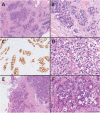Histology of Luminal Breast Cancer
- PMID: 32982642
- PMCID: PMC7490665
- DOI: 10.1159/000509025
Histology of Luminal Breast Cancer
Abstract
Background: Invasive breast cancer (IBC) can be categorized into prognostic and predictive molecular subtypes (including luminal breast cancer) using gene expression profiling. Luminal IBC comprises a variety of histological subtypes with varying clinical and pathological features.
Summary: IBC of no special subtype is the most common histological subtype in general and likewise within luminal IBC. Classical invasive lobular breast cancer, typically clustering into luminal subgroup, is characterized by discohesive growth and loss of E-cadherin expression. Infrequent, morphologically distinct luminal IBC subtypes are tubular, invasive cribriform, mucinous, and invasive micropapillary carcinomas. Breast carcinoma with apocrine differentiation, with characteristic expression of androgen receptor (AR), often clusters into the luminal AR category. Rarely, neuroendocrine neoplasms of the breast can be seen. IBC of the male breast usually matches with the luminal subtype.
Key messages: Independently from histological subtypes, invasive breast cancer (IBC) can be divided into molecular subtypes based on mRNA gene expression levels. Using this molecular subtyping, risk scores based on gene expression profiling (established for hormone receptor-positive, HER2-negative IBC), grading, and Ki-67 index, prognosis of patients with luminal breast cancer and response to chemotherapy can be predicted. In routine diagnostics, the expression of estrogen receptor (ER) and progesterone receptor (PR), HER2 status, and the proliferation rate (Ki-67) are used to determine a surrogate (molecular-like) subtype. Within luminal(-like) IBC, no special subtype and invasive lobular breast carcinoma are the most common histological subtypes. Other rare histological subtypes (e.g., tubular carcinoma) should be recognized due to their distinct clinical and pathological features.
Keywords: Breast cancer; Estrogen receptor; Histological subtypes; Luminal A; Luminal B.
Copyright © 2020 by S. Karger AG, Basel.
Conflict of interest statement
R.E. has received honoraria from Roche, Novartis, Pfizer, and Eisai, reimbursement of traveling expenses from BioNTech and research funding from NanoString Technologies, Cepheid, BioNTech, and Zytomed Systems. A.H. has received honoraria from Bristol-Myers Sqibb, MSD, Roche, AstraZeneca, Boehringer Ingelheim, Abbvie, Janssen-Cilag, and Ipsen, and research funding from Cepheid, BioNTech AG, Roche, Janssen-Cilag, NanoString Technologies, and AstraZeneca. Moreover, he has acted as consultant/in advisory role for Bristol-Myers Sqibb, MSD, Roche, Cepheid, Qiagen, Janssen-Cilag, AstraZeneca, Ipsen, and NanoString Technologies (also expert testimony), Illumina, 3DHISTECH, and Diaceutics.
Figures



Similar articles
-
Luminal B, Human Epidermal Growth Factor Receptor 2 (HER2/neu), and Triple-Negative Breast Cancers Associated With a Better Chemotherapy Response Than Luminal A Breast Cancers in Postneoadjuvant Settings.Cureus. 2023 Jun 6;15(6):e40066. doi: 10.7759/cureus.40066. eCollection 2023 Jun. Cureus. 2023. PMID: 37425505 Free PMC article.
-
Long-term treatment efficacy in primary inflammatory breast cancer by hormonal receptor- and HER2-defined subtypes.Ann Oncol. 2014 Feb;25(2):384-91. doi: 10.1093/annonc/mdt525. Epub 2013 Dec 18. Ann Oncol. 2014. PMID: 24351399 Free PMC article.
-
[Correlations of Androgen Receptor Expression with Molecular Subtypes and Clinopathological Features of Invasive Breast Carcinoma of No Special Type in Tibet].Zhongguo Yi Xue Ke Xue Yuan Xue Bao. 2022 Dec;44(6):1033-1039. doi: 10.3881/j.issn.1000-503X.14724. Zhongguo Yi Xue Ke Xue Yuan Xue Bao. 2022. PMID: 36621794 Chinese.
-
Triple-negative pleomorphic lobular carcinoma and expression of androgen receptor: Personal case series and review of the literature.PLoS One. 2020 Jul 22;15(7):e0235790. doi: 10.1371/journal.pone.0235790. eCollection 2020. PLoS One. 2020. PMID: 32697770 Free PMC article. Review.
-
Invasive Lobular Breast Cancer as a Distinct Disease: Implications for Therapeutic Strategy.Oncol Ther. 2020 Jun;8(1):1-11. doi: 10.1007/s40487-019-00105-0. Epub 2019 Dec 24. Oncol Ther. 2020. PMID: 32700069 Free PMC article. Review.
Cited by
-
Construction and Validation of a Novel Nomogram for Predicting the Risk of Metastasis in a Luminal B Type Invasive Ductal Carcinoma Population.World J Oncol. 2023 Dec;14(6):476-487. doi: 10.14740/wjon1553. Epub 2023 Nov 3. World J Oncol. 2023. PMID: 38022397 Free PMC article.
-
Contrast-enhanced ultrasound for the preoperative prediction of pathological characteristics in breast cancer.Front Oncol. 2024 Feb 29;14:1320714. doi: 10.3389/fonc.2024.1320714. eCollection 2024. Front Oncol. 2024. PMID: 38487727 Free PMC article.
-
A deep learning model for breast ductal carcinoma in situ classification in whole slide images.Virchows Arch. 2022 May;480(5):1009-1022. doi: 10.1007/s00428-021-03241-z. Epub 2022 Jan 25. Virchows Arch. 2022. PMID: 35076741
-
Breast Cancer-Epidemiology, Risk Factors, Classification, Prognostic Markers, and Current Treatment Strategies-An Updated Review.Cancers (Basel). 2021 Aug 25;13(17):4287. doi: 10.3390/cancers13174287. Cancers (Basel). 2021. PMID: 34503097 Free PMC article. Review.
-
Prognostic significance of grade of malignancy based on histopathological differentiation and Ki-67 in pancreatic ductal adenocarcinoma.Cancer Biol Med. 2024 Jan 3;21(5):416-32. doi: 10.20892/j.issn.2095-3941.2023.0363. Cancer Biol Med. 2024. PMID: 38172499 Free PMC article.
References
-
- WHO Classification of Tumours Editorial Board Breast Tumours. Lyon (France): International Agency for Research on Cancer; 2019 (WHO classification of tumours series, 5th ed.; vol. 2), p.87,102-104. https://publications.iarc.fr/581.
-
- Moinfar F. Essentials of Diagnostic Breast Pathology, Practical Approach. 1st ed. Berlin: Springer; 2007.
-
- Weigelt B, Horlings HM, Kreike B, Hayes MM, Hauptmann M, Wessels LF, et al. Refinement of breast cancer classification by molecular characterization of histological special types. J Pathol. 2008 Oct;216((2)):141–50. - PubMed
Publication types
LinkOut - more resources
Full Text Sources
Research Materials
Miscellaneous

